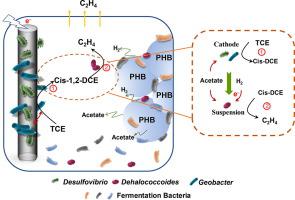当前位置:
X-MOL 学术
›
Chem. Eng. J.
›
论文详情
Our official English website, www.x-mol.net, welcomes your
feedback! (Note: you will need to create a separate account there.)
Directional bioelectrochemical dechlorination of trichloroethene to valuable ethylene by introduction poly-3-hydroxybutyrate as a slow release carbon source
Chemical Engineering Journal ( IF 13.3 ) Pub Date : 2022-12-05 , DOI: 10.1016/j.cej.2022.140737 Xueqi Chen , Caihua Bai , Zhiling Li , Di Cao , Yunxia Zu , Zimeng Zhang , Guanshu Zhao , Jun Nan , Hongcheng Wang , Bin Liang , Aijie Wang
Chemical Engineering Journal ( IF 13.3 ) Pub Date : 2022-12-05 , DOI: 10.1016/j.cej.2022.140737 Xueqi Chen , Caihua Bai , Zhiling Li , Di Cao , Yunxia Zu , Zimeng Zhang , Guanshu Zhao , Jun Nan , Hongcheng Wang , Bin Liang , Aijie Wang

|
Bioelectrochemical dechlorination is one of the prospective and economic strategies for remediation of halogenated organics contaminated site, however, exploring the way of system construction with high detoxification efficiency and low organocarbon risk is still challenging. Herein, the slow-release organic carbon-sources (SOCs) coupled bioelectrochemical dechlorination system with generally accelerated trichloroethene (TCE) dechlorination performance and controllable organocarbon release was reported. It is interestingly found the introduction of Poly-3-hydroxybutyrate (PHB) achieved the greatly improved dechlorination efficiency (2.23 times improved value) with valuable ethylene as a major metabolite (recovery ratio of 94.00 ± 1.62 %), reflecting the superior TCE detoxification and ethylene recovery potential. Microbial molecular mechanism analysis revealed the enriched electroactive dechlorinators ( and ) in cathode representing the positive correlation (r > 0.8, p < 0.05) with TCE removal, were involved in the accelerated TCE dechlorination to 1,2-DCE. The non-electroactive dechlorinator () observed in suspension symbiotically cooperating with some fermenters (, , etc.) and positively correlating with 1,2-DCE removal, was responsible for dechlorination of 1,2-DCE to ethylene through utilizing PHB fermentation generated H as electron donor. PHB coupled bioelectrochemical dechlorination system realized the quick and directional conversion of TCE to ethylene, while maintaining the organocarbon release at a controllable and stable level, providing a feasible approach for simultaneous pollution removal and resource recovery by applying bioelectrochemical system in chlorinated hydrocarbon contaminated field.
中文翻译:

引入聚-3-羟基丁酸酯作为缓释碳源,将三氯乙烯定向生物电化学脱氯为有价值的乙烯
生物电化学脱氯是卤代有机物污染场地修复的一种具有前瞻性和经济性的策略之一,但探索高脱毒效率和低有机碳风险的系统构建方式仍然具有挑战性。本文报道了缓释有机碳源(SOC)耦合生物电化学脱氯系统,具有普遍加速的三氯乙烯(TCE)脱氯性能和可控的有机碳释放。有趣的是,聚3-羟基丁酸酯(PHB)的引入实现了以有价值的乙烯为主要代谢物的脱氯效率的大幅提高(提高了2.23倍)(回收率为94.00±1.62%),体现了优异的TCE解毒和乙烯回收潜力。微生物分子机制分析表明,阴极中富集的电活性脱氯剂( 和 )与 TCE 去除呈正相关(r > 0.8,p < 0.05),参与了 TCE 加速脱氯为 1,2-DCE。在悬浮液中观察到的非电活性脱氯剂( )与一些发酵罐( , 等)共生合作,并与 1,2-DCE 去除呈正相关,负责通过利用 PHB 发酵产生的 H 将 1,2-DCE 脱氯为乙烯。作为电子供体。 PHB耦合生物电化学脱氯系统实现了三氯乙烯快速定向转化为乙烯,同时保持有机碳释放在可控稳定水平,为氯代烃污染场应用生物电化学系统同时进行污染去除和资源回收提供了可行途径。
更新日期:2022-12-05
中文翻译:

引入聚-3-羟基丁酸酯作为缓释碳源,将三氯乙烯定向生物电化学脱氯为有价值的乙烯
生物电化学脱氯是卤代有机物污染场地修复的一种具有前瞻性和经济性的策略之一,但探索高脱毒效率和低有机碳风险的系统构建方式仍然具有挑战性。本文报道了缓释有机碳源(SOC)耦合生物电化学脱氯系统,具有普遍加速的三氯乙烯(TCE)脱氯性能和可控的有机碳释放。有趣的是,聚3-羟基丁酸酯(PHB)的引入实现了以有价值的乙烯为主要代谢物的脱氯效率的大幅提高(提高了2.23倍)(回收率为94.00±1.62%),体现了优异的TCE解毒和乙烯回收潜力。微生物分子机制分析表明,阴极中富集的电活性脱氯剂( 和 )与 TCE 去除呈正相关(r > 0.8,p < 0.05),参与了 TCE 加速脱氯为 1,2-DCE。在悬浮液中观察到的非电活性脱氯剂( )与一些发酵罐( , 等)共生合作,并与 1,2-DCE 去除呈正相关,负责通过利用 PHB 发酵产生的 H 将 1,2-DCE 脱氯为乙烯。作为电子供体。 PHB耦合生物电化学脱氯系统实现了三氯乙烯快速定向转化为乙烯,同时保持有机碳释放在可控稳定水平,为氯代烃污染场应用生物电化学系统同时进行污染去除和资源回收提供了可行途径。


















































 京公网安备 11010802027423号
京公网安备 11010802027423号